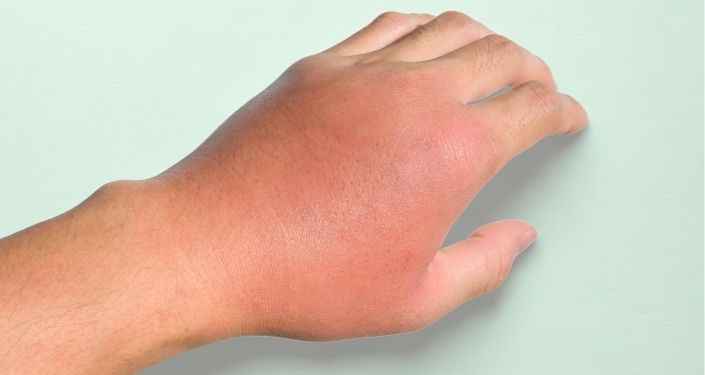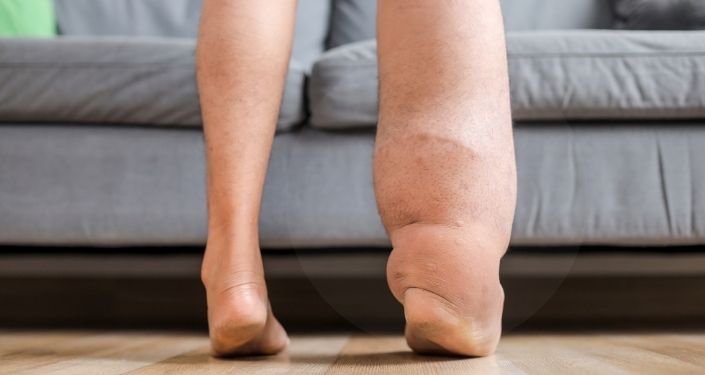Living with lymphedema can feel scary, especially when you’re not sure what to watch out for. I get it – you may want to know: is lymphedema dangerous?
Hi, my name is Kelly, and I am a certified oncology and lymphedema therapist. I specialize in helping people manage their symptoms so they can focus on what’s most important to them.
As a certified lymphedema therapist, I have worked with many patients who have struggled with the symptoms that come from having lymphedema. Lymphedema can cause serious complications if left untreated, but you don’t have to live in fear. When you understand what to watch for and have a good management plan, you can live an active, fulfilling life.
Let me walk you through some of the potential risks someone may face if they don’t manage their lymphedema, and different ways to treat lymphedema to avoid dangerous complications.
What is Lymphedema?
Lymphedema refers to a condition in which chronic swelling occurs within the body because your lymphatic system can’t properly drain fluid, called lymph, from your tissues. Your lymphatic system is part of your body’s immune system, which helps drain excess fluid and fight infections.
Lymphedema is often seen after surgery, radiation, or injury, but can also happen on its own. Common symptoms include swelling, heaviness, and skin changes.
What Causes Lymphedema?
Numerous factors can increase someone’s chance of developing secondary lymphedema, the most common being if someone has had surgical procedures involving their lymph nodes. This is often the case for many people who have undergone cancer treatment, specifically breast cancer surgery, where lymph nodes have been removed.
Lymphedema can also be caused by:
- Radiation treatment
- Chronic inflammation
- Immobility
- Trauma or infection
- Obesity
What are the Signs and Symptoms of Lymphedema?
The most common symptom of lymphedema is increased swelling in an area of the body that becomes more severe if left untreated. Other lymphedema signs to look out for include:
- A feeling of heaviness or tightness
- Fatigue
- Reduced mobility
- Thickened or hardened skin
- Pain or discomfort
- Recurring infections
What are the Risks of Leaving Lymphedema Untreated?
Lymphedema is a serious medical condition that, if left untreated, can cause severe complications.
If you would like to follow along with a video of a certified physical therapist discussing the dangers of leaving lymphedema untreated, you can watch the YouTube video linked below.
1. Skin Infections
One of the first risks of untreated lymphedema is the potential for skin infections, specifically cellulitis. Cellulitis can occur when lymphatic fluid pools in an area of the body and remains congested.
When your lymph system is working properly, lymph fluid moves to your the lymph nodes where it is filtered to remove toxins, bacteria, and waste. But when that fluid gets trapped, it creates the perfect environment for bacteria to grow. Add a small cut or scape to the area, and bacteria can enter through the skin, increasing the risk for potential infection.

If you notice swollen, red skin that is painful to touch, or develop a fever, it is crucial to seek medical attention right away. Cellulitis can develop into sepsis, a life-threatening condition where the body’s response to infection starts damaging its own tissues.
Symptoms of Cellulitis
- redness
- warmth
- pain
- fever
Your health is important, and if you notice swollen, red skin, do NOT DELAY seeking medical attention.
2. Blistering or Leakage Through the Skin
With severe swelling, also known as venous swelling, the lymph fluid may find its way out through small breaks in your skin on the affected arm or leg and may even cause blistering.
Over time, this trapped lymphatic fluid can break the skin down from the inside out and lead to increased swelling and risk for infection.
3. Fibrosis
In severe lymphedema cases, the skin may thicken and harden, a condition called Fibrosis. This affects the physical appearance of one’s skin but also indicates advanced stages of lymphedema. It’s ideal to seek medical attention from a certified lymphedema therapist before it reaches this point.
When lymphedema progresses to this stage, it is much more challenging to manage and treat. During this stage, treatment with multilayer compression bandaging and foams may be needed, and I always recommend seeking support from a certified lymphedema therapist to ensure you are getting the care you need.
What are the Treatment Options for Lymphedema?
The primary goal of lymphedema treatment is to reduce swelling, improve lymphatic drainage, and reduce the potential for complications. There are four stages of lymphedema, and lymphedema treatment is important at each stage.

When you first develop lymphedema, you will want to work with a certified lymphedema therapist to complete a cycle of Complete Decongestive Therapy (CDT). CDT is an intense treatment that combines manual lymphatic drainage, physical therapy, regular exercise, compression therapy, and other treatment options to reduce swelling as much as possible.
Following this treatment, it’s important to establish regular lymphedema self-care routines at home to help maintain your progress and improve your quality of life. Lymphedema treatment at home may include:
- Wearing compression garments to support pressure on the affected area and improve lymphatic flow
- Lymphatic drainage massage, which is a massage treatment to help move fluid through the lymphatic vessels
- Regular physical exercise to help move lymph fluid and build strength
- Elevating the affected limb
- Deep breathing
- Maintaining a healthy weight
Final Thoughts
Lymphedema is a serious medical condition that, if left untreated, can cause dangerous complications. However, you don’t have to live with your uncomfortable lymphedema symptoms. There are ways to manage lymphedema and live a normal quality of life.
If you or someone you know is experiencing lymphedema, it is important to seek medical attention to explore treatment options with a certified lymphedema therapist.
FAQs
What is the Life Expectancy of Someone With lymphedema?
Someone with lymphedema can still have a normal life expectancy if they are actively managing their lymphedema with proper treatment, such as wearing compression stockings, doing manual lymphatic drainage, and maintaining regular physical activity. It’s important to have a consistent lymphedema self-care routine at home to prevent dangerous complications such as cellulitis.
What is the Best Cure For lymphedema?
While there is no cure for lymphedema, someone can effectively manage their lymphedema symptoms through treatment and taking proactive measures to ensure that their lymphedema doesn’t result in severe complications.
You can work with a lymphedema specialist in your area and find more support in Lower Body Lymphedema Rehab.
What is the Best Treatment for Lymphedema in the Legs?
There are different treatment options for someone who has lymphedema in their legs, which can include: Complete Decongestive Therapy (CDT, regular physical exercise, full body lymphatic drainage, and wearing compression garments and bandages.
Unfortunately, lymphedema is a chronic condition with no cure. While you may always live with some degree of leg lymphoedema, there are ways to manage your symptoms and improve your quality of life.
What Should You Not Do if You Have Lymphedema?
If you have lymphedema, avoid extreme temperatures that can cause damage to your skin – like burns or frostbite. Don’t ignore even small cuts, scrapes, or bug bites – clean them right away and watch for signs of infection. Skip tight jewelry, watches, or restrictive clothing that can block lymph flow. If your swelling suddenly gets worse or your skin becomes red and warm, seek medical attention right away.











